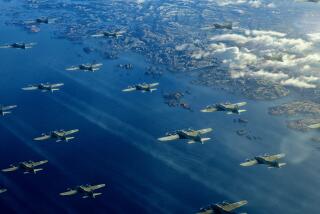Spreading Their Wings : Black WW II Airmen’s New Mission Is to Inspire and Motivate Youths
They journeyed from the cotton fields of Mississippi, the foundries of Detroit and the colleges of the West to become catalysts for the “noble experiment”--all-black World War II Army Air Corps units.
And they succeeded. These first black pilots flew 200 missions in Europe, escorting bombers during Allied air strikes and gaining the respect of German airmen who knew them as the “Black Birdmen.” The aviators never lost a bomber in those heavy escort missions over Germany.
By the end of the war, their gallantry under fire had put aside doubts about the abilities of black pilots and paved the way for African-Americans to serve side by side with white airmen in the U.S. military.
“There’s nothing in the world like flying a fighter,” said Sun City resident Charles M. Bussey, 71, who flew with the 332nd Fighter Group, which saw action in Italy. “That’s the proudest you can get. I had to make it (through flight school). That’s what I wanted to do and (putting up with racial harassment) was the price I had to pay. No American should have to pay that price, but we did.”
Today, 50 years after the formation of their first squadron, the former airmen are fighting on another front. Their new mission is to inspire and motivate young blacks and other Americans. Their sorties consist of speeches to schoolchildren, civic groups and university students.
“We tell them to never strive for nothing less than the best,” said O. Oliver Goodall, an Inglewood resident who flew with the 477th Bombardment Group, which underwent intense training but did not see action. “Don’t let your peers, family members, no one, tell you what you can’t do.”
Goodall, a retired postal worker, is public information officer for the Los Angeles chapter of Tuskegee Airmen Inc., a nonprofit national organization of the former pilots and supporters. The Los Angeles chapter is among the largest of 38 Tuskegee Airmen chapters across the country.
The organization funds educational programs and awards scholarships to disadvantaged youths seeking careers in aviation or aerospace. The black airmen have been celebrating the 50th anniversary of the graduation of their first pilot class at air shows across the country.
The Tuskegee Airmen, named after the Tuskegee, Ala., airfield where they were trained, tell of the racial harassment and segregation they endured in the service. Many classmates, they say, were drummed out of flight school on flimsy pretexts. The remaining pilots trained on outdated planes under white instructors who were sometimes assigned to Tuskegee as punishment, they say.
“It was an ugly place to be,” said Bussey, a retired Army lieutenant colonel. “The barracks had never been finished. We had for the most part Deep Southern instructors, some of whom were very rabid in their hatred of black folks.”
The pilots were not given survival training, he said, a costly omission once they entered combat.
“The lack of that survival skill, specifically swimming, caused an awful lot of deaths,” Bussey said. “As a result of this we lost many, many fine pilots. I was bitter about it then. I’m bitter about it now.”
The Tuskegee experience, the airmen say, has made them uniquely qualified as role models.
“There have never been any black role models of the stature of the Tuskegee Airmen,” said Clint Martin, 53, an Inglewood resident who has spent thousands of hours painstakingly creating models of planes flown by the black pilots. “These guys are real American heroes.”
Martin’s models have been displayed at museums and Air Force bases across the country. His childhood dreams were of following in the footsteps of two black pilots from his McComb, Miss., neighborhood. Although he never became a pilot because of a hearing problem, he enlisted in the Air Force.
Because their unit’s aircraft markings included red-painted tail sections, the Tuskegee fliers were dubbed the “red tails.” Almost 1,000 African-American pilots graduated from the Tuskegee Army Air Corps Flying School, and 450 went on to fly in combat in North Africa and Europe.
The Tuskegee experience began with the first graduating class of five pilots in March, 1942. The pilots formed the 99th Fighter Squadron and, as more aviators graduated, their unit grew to include three more fighter squadrons and four bomber units. However, political pressures and the winding down of the war prevented the bomber units from serving overseas.
In addition to escorting heavy bombers over Germany, the fighter squadrons flew thousands of sorties in Europe and North Africa in planes such as the P-47 Thunderbolt and P-51 Mustang, losing 67 pilots to enemy fire.
Yet, the survivors say, their efforts have gone largely unrecognized until recently with the airing of a television documentary and newspaper stories about their exploits. The Tuskegee Airmen say they find that people are surprised to learn of the unit’s existence.
Several aviators went on to become high-ranking Air Force officers. If the Tuskegee Airmen were able to overcome the color barrier in the military, they say, then young blacks can overcome urban obstacles.
“We want to pass on to our children, our children’s children, and to all the children that you can do something if you’re prepared and if you’re willing to work,” said Roger C. (Bill) Terry, 70, an Inglewood resident and retired probation officer who flew with the 477th Bombardment Group.
He was one of the “Freeman Field Three” who in 1945 were arrested and court-martialed for entering a “whites only” officers club in Indiana. Terry said he was the only one convicted and he was disciplined and fined $150.
The incident at the airfield in Seymour, Ind., was widely publicized and is viewed by the airmen as one of the first stirrings of the civil rights movement.
Today, Terry is president of the 150-member Los Angeles chapter of the Tuskegee Airmen.
“There was nowhere in this country where they had more patriotic men, in spite of what they had to face--the segregation, the downgrading of individual abilities,” Terry said. “Outside of being able to fly, my greatest thrill was that I was with so many men who were dedicated to the proposition that we were good, that we could do, and that we did do.”
That message is being taken to inner-city schools by the airmen, whose uniforms consist of blue blazers adorned with commemorative pins and, of course, their wings.
“Ever since I was a little kid I wanted to fly,” said Rusty Burns, who flew with the 99th Fighter Squadron but did not see combat. “It was a fantasy until I was a senior in high school. I envisioned being a fighter pilot. When I graduated and got in a P-40, that was the most outstanding pleasure in my career.”
Burns, 66, of Simi Valley, still flies civilian planes, commercially and for pleasure. He is a retired corporate manager of travel services for an aerospace company. Recently, he strolled through the Chino Airport Museum, marveling at World War II fighter planes such as the P-51 Mustang.
“It’s hard for me to describe the feeling of flying it,” Burns said. “It was the best. We knew that and felt confident in it. The Tuskegee experience is something you can never duplicate. I never realized it at the time, but there is great sense of accomplishment now for having been a part of it.”
More to Read
Sign up for Essential California
The most important California stories and recommendations in your inbox every morning.
You may occasionally receive promotional content from the Los Angeles Times.










